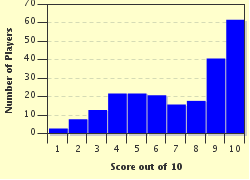Quiz Answer Key and Fun Facts
1. The patron saint of Ireland is Saint Patrick. It was Saint Patrick who led the Irish people to Christianity. In what year did Saint Patrick arrive in Ireland to begin the conversion of Irish kings to Christianity?
2. In Ireland's early history, there were many High Kings who ruled over the island. One of the best known of these was Brian Boru. Brian Boru was the first High King to defeat the Viking invaders at a significant battle and he also managed to consolidate many of the chieftains and other leaders on the island to fight as one, if only briefly. He was killed in one of the most famous battles in Irish history, fought in 1014 AD. In which battle was Brian Boru killed?
3. Between 1845 and 1852 the population of Ireland fell by between 20% and 25% due to a combination of death and emigration. What was the root cause of this dramatic decline?
4. The Battle of the Boyne took place in 1690. The Protestant William of Orange defeated the forces of the Catholic King James, and his victory ensured that Protestant influence over Ireland would continue for centuries. Near what town did this battle occur?
5. In 1607, a French ship set sail from Ireland with Hugh O'Neill, the Earl of Tyrone, and Rory O'Donnell, the Earl of Tyrconnell. They were headed for Spain but their ship ran into bad weather and they disembarked in France. Known as the "Flight of the Earls", where did the Earls and their followers finally settle?
6. The Irish Flag also referred to as the tricolour is made up of the colours green, white and orange. Who is credited with the formation and presentation of this flag to the Irish nation?
7. When I visited Dublin I took a history tour. The many historic statues in the city are given very funny names by the locals. Which famous Dublin statue is sometimes referred to as "The Prick with the Stick"?
8. On Easter Monday 1916, a committed group of over 1,200 Volunteers and Citizen Army members started a rebellion with the objective of establishing an Irish Republic. In which public building in Dublin did the rebels establish their headquarters?
9. What was the name of the Irish Republican Army death squad that Michael Collins caused to be formed in 1919?
10. Ending on a less serious but no less momentous historical note ... in 2003 Rosanna Davison became Ireland's first winner of the Miss World beauty pageant. Who is her famous singer dad, who wrote a song for her on his 'Into The Light' album?
Source: Author
dolano
This quiz was reviewed by FunTrivia editor
bloomsby before going online.
Any errors found in FunTrivia content are routinely corrected through our feedback system.

